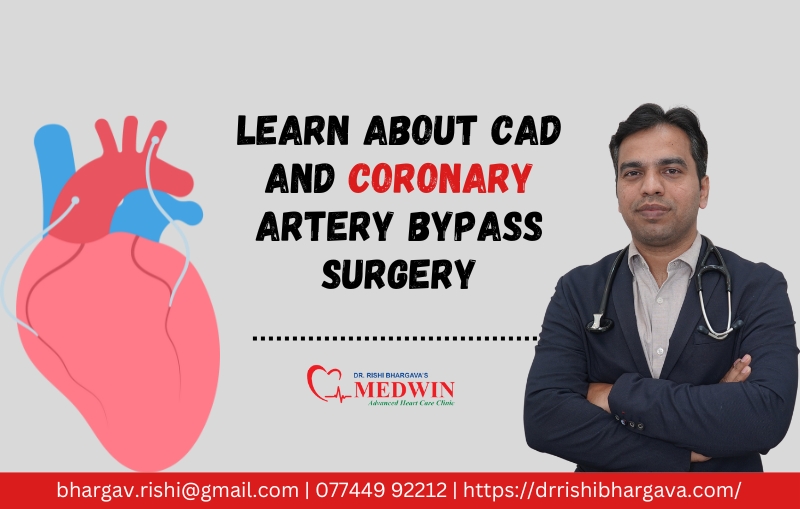Learn About CAD and Coronary Artery Bypass Surgery

We are aware that the body contains two distinct forms of cholesterol HDL or good cholesterol and LDL or bad cholesterol. The good cholesterol moves all the fat to the liver and prevents this obstruction, whereas LDL, or the bad cholesterol, attempts to stiffen the arteries and block the blood vessels. If a person’s body contains too much harmful cholesterol, it deposits as plaque on the artery walls. This may lead to coronary artery disease (CAD) in addition to causing arterial damage. The walls of arteries get clogged with fatty material, inflammatory cells, cellular waste materials, etc. when a person develops coronary artery disease. The cardiac muscles struggle to circulate oxygenated blood due to this obstruction. Due to the cells unable to expel their waste, it builds up in the artery walls and prevents the heart from functioning properly. Both the arteries and the blood vessels are harmed by this plaque buildup. This explains why Coronary Artery Disease, or CAD, can be an extremely deadly condition. It can also be the primary cause of complete heart failure and heart attacks.
Symptoms of Coronary Artery Disease (CAD)
It takes over decades for coronary artery disease to develop. Coronary Artery Disease is a silent killer. It’s possible that symptoms won’t be discovered until a heart attack or a large blockage occurs in heart. But you may experience slight discomfort as your arteries get narrowed. These signs indicate that your heart is working harder to pump blood that is high in oxygen to your body. Coronary Artery Disease (CAD) symptoms include:
- Angina or feeling of pain, tightness and heaviness in the chest – one of the most common symptoms. It can be experienced in heart as well as left arm, shoulder, back, neck and jaws.
- Shortness of breath
- Unusual heavy sweating
- Extreme weakness and fast heart beat
- Dizziness and nausea
- Lightheadedness and digestive problems
Treatment for Coronary Artery Disease (CAD)
There are numerous treatment options for artery disease. The number of arteries that has blockages determines the type of treatment that is needed. A nutritious diet, healthy lifestyle, medication, and the use of stents can all be recommended to treat a person who has just one or two clogged arteries. On the other hand, Coronary Artery Bypass Graft, or CABG, surgery is recommended if three or more arteries are clogged.
What is Coronary Artery Bypass Surgery?
Patients with severe Coronary Heart Disease are recommended to undergo coronary artery bypass grafting. During the surgery, an alternative route to the heart is created, which facilitates better blood circulation and heart health. A healthy vein or artery is transplanted to the clogged artery during CABG. This vein, which is attached to the clogged artery, is designed to avoid the coronary artery’s blocked section. This leaves the area around the blockage accessible for the oxygenated blood to flow through the heart.
Coronary Artery Bypass Surgery Details
Before the surgery, the cardiologist suggests to undergo various tests to check if the patient is safe to have this surgery. The potential tests include:
- Echocardiogram (echo)
- Electrocardiogram (EKG/ECG)
- Blood & Urine tests
- Cardiac catheterization
- Computed tomography (CT) coronary angiogram
- Heart MRI (magnetic resonance imaging)
- Coronary calcium scan
- Exercise stress test
- Chest X-ray
The patient is prepared for surgery after all the testing is finished. Under standard anaesthesia, the surgery takes around three to six hours to complete. During the procedure, a breathing tube that is connected to a ventilator is inserted into the patient’s mouth by the cardiology surgeon. The patient is subsequently given medication by the surgeon to stop their heart from beating. The heart is then cut through an incision. When the heart is not functioning, a machine that assists in supplying blood and oxygen to the entire body is attached to the body. The aorta is then joined to a blood vessel that was taken from another area of your body. The artery below the blockage is connected to the opposite end of this blood channel. The number of times the surgeon performs the same procedure will depend on how many arteries are blocked. After the bypass is implanted, the surgeon can restore blood flow and, if necessary, restart your heart. After that, surgeon wires your rib cage together so it can recover and lower it back into position. With the use of sutures and staples (stitches) incision in your chest is sealed.
Consult for Coronary Artery Bypass Graft (CABG) Surgery at Medwin Heart Care Clinic
Coronary Artery Bypass Graft, or CABG surgery is a major procedure and can bring a huge change in your overall quality of life. Hence, it is important to consult experienced cardiologist to offer comprehensive resources and treatment options to help you overcome with any heart related disease. Dr. Rishi Bhargava, a consultant interventional cardiologist at Medwin Heart Care Clinic in Kharghar, Navi Mumbai has a decade years of experience in treating complex and acute heart ailments. You can find the best facilities, top class treatments and complete personalized attention from the cardiologist at nominal cost. Book an appointment with Dr Rishi A. Bhargava at Medwin Heart Care Clinic and learn more about Coronary Artery Disease and Coronary Artery Bypass Surgery.




